Building on the Town’s History
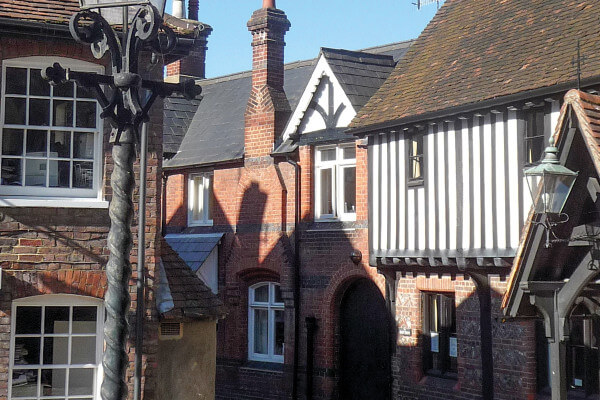
Taking a closer look at some of Berkhamsted’s historic buildings.
When you live or work in the town, it’s easy to not notice some of the fabulous buildings you pass as you hurry to the office or head out to do the shopping. But next time you’re on the High Street, take a moment to take a good look at what’s around you.
There’s architecture covering hundreds of years of history, from the Victorian Town Hall and Tudor houses to Carolean almshouses and the oldest extant jettied timber-framed building in England.
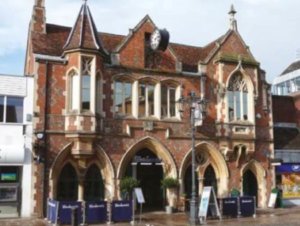
One building that’s hard to miss, with its ornate frontage, is the Town Hall. This neo-Gothic building was designed by Victorian architect Edward Buckton Lamb – sometimes described as a ‘Rogue-Gothic Revivalist’. It was designed to offer a public meeting room, a market hall and to be home to the Berkhamsted Mechanics’ Institute, when it was built in 1859.
The eccentric architect was chosen to design the building by Lady Marion Alford, the mother of the young Earl Brownlow. And his other sponsors were no less worthy.
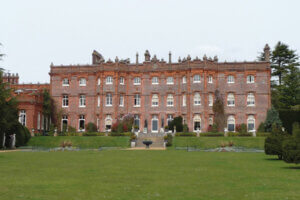 He was responsible for the Disraeli Monument on Tinker’s Hill in Hughenden Valley near High Wycombe, which politician Benjamin Disraeli described as ‘both for design, execution and even material is one of the most beautiful things not only in the County of Buckingham, but in England!’ He was so impressed that he commissioned Lamb to remodel Hughenden Manor.
He was responsible for the Disraeli Monument on Tinker’s Hill in Hughenden Valley near High Wycombe, which politician Benjamin Disraeli described as ‘both for design, execution and even material is one of the most beautiful things not only in the County of Buckingham, but in England!’ He was so impressed that he commissioned Lamb to remodel Hughenden Manor.
Despite his popularity among the wealthy, Lamb was criticised for breaking convention. Although he was later described by Nikolaus Pevsner, an art historian and architectural historian, as ‘the most original though certainly not the most accomplished architect of his day’.
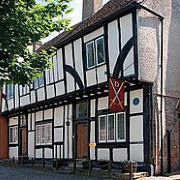
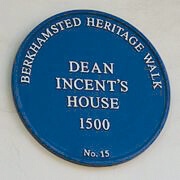 Pevsner, who wrote a 46-volume series of county-by-county guides, The Buildings of England, also identified Dean Incent’s House (across from Saint Peter’s Church) as ‘the best house in Berkhamsted.’ The timber-framed house was built in the latter part of the 15th century and not only was it the birthplace of John Incent (1480-1545), who was chaplain to Henry VIII during his divorce from Catherine of Aragon, and became Dean of Saint Paul’s Cathedral, London, from 1540 to 1545, but it belonged to Robert and Katherine Incent. Robert Incent was secretary to Cecily Neville, Duchess of York, who was the last royal resident at Berkhamsted Castle, and mother of two kings – Edward IV and Richard III. The castle became her primary residence in 1471. She died in 1495.
Pevsner, who wrote a 46-volume series of county-by-county guides, The Buildings of England, also identified Dean Incent’s House (across from Saint Peter’s Church) as ‘the best house in Berkhamsted.’ The timber-framed house was built in the latter part of the 15th century and not only was it the birthplace of John Incent (1480-1545), who was chaplain to Henry VIII during his divorce from Catherine of Aragon, and became Dean of Saint Paul’s Cathedral, London, from 1540 to 1545, but it belonged to Robert and Katherine Incent. Robert Incent was secretary to Cecily Neville, Duchess of York, who was the last royal resident at Berkhamsted Castle, and mother of two kings – Edward IV and Richard III. The castle became her primary residence in 1471. She died in 1495.
John Incent also played a major part in Berkhamsted’s history, founding Dean Incent’s Free School in Berkhamsted in 1541 – today it is Berkhamsted School.
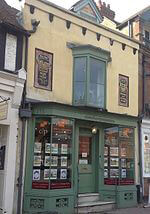 At 173 High Street, almost opposite WH Smith, you’ll find what is thought to be the oldest extant jettied timber-framed building in England, dating back to the late 13th century. Although its facade dates back to Victorian times, its medieval timber frame came to light during renovations at the start of this century.
At 173 High Street, almost opposite WH Smith, you’ll find what is thought to be the oldest extant jettied timber-framed building in England, dating back to the late 13th century. Although its facade dates back to Victorian times, its medieval timber frame came to light during renovations at the start of this century.
At the time, Dr Simon Thurley, Chief Executive of English Heritage, said: ‘This is an amazing discovery. It gives an extraordinary insight into how Berkhamsted High Street would have looked in medieval times.’
While evidence that its life before it became a pharmacy was as a jeweller or goldsmith’s shop with a workshop behind prompted claims that it was the country’s oldest shop, there are doubts about how long it has actually been a shop – and is now believed to have originally been a jettied service wing to a larger house. The Grade II* Listed building is now home to Sterling estate agents.
To the 16th Century now and the Tudor Court House, now the parish hall (pictured, top), that sits next to Saint Peter’s Church. This timber-framed building is made from red brick and knapped flint and has a jettied wooden
first floor, and it’s believed that it may have been built on the site of an earlier, medieval building.
It could be considered the town’s first town hall, as the town council first met there in 1618. The courts of the Manor and Honour of Berkhamsted, held on Whit Tuesday and on the Tuesday after Michaelmas, met to hear ‘all pleas, actions, suits or offences against the laws and liberty of the manor’.
In 1838 it became the home of the National School (which would have provided elementary education for the poor), when additional rooms were built on the back of the house, and the cottage next door was built for the schoolmaster.
The Court House has had other uses – it was used as an orderly room in World War I, was an extension hospital during the Spanish Flu epidemic in 1918, and became a school once more to cope with the influx of evacuees.
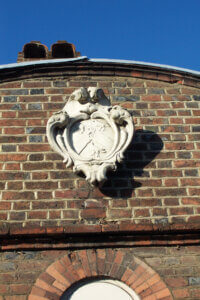 The Sayer Almshouses on the corner of Cowper Road, meanwhile, have offered homes to the benefit of people in need for almost 350 years.
The Sayer Almshouses on the corner of Cowper Road, meanwhile, have offered homes to the benefit of people in need for almost 350 years.
They were given to the town by John Sayer, who was Charles II’s chief cook and a friend of Samuel Pepys. He lived in Berkhamsted Place.
Sayer bequeathed £1,000 in trust ‘for the building of an almshouse and the purchasing of lands for the relief of the poor in Berkhamsted St Peter’, and it was his wife Mary who saw that his wishes were fulfilled. The buildings cost £269, and the rest of the money was invested.
You can find Sayer’s black and white marble tomb in the Lady Chapel of St Peter’s church on the High Street.
